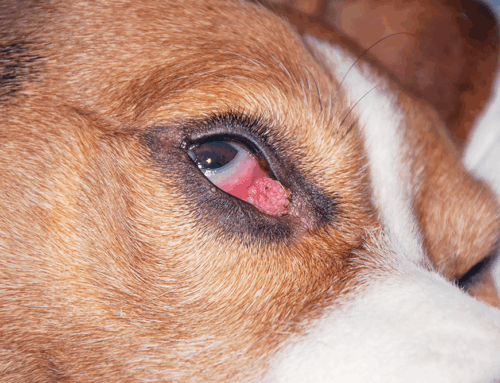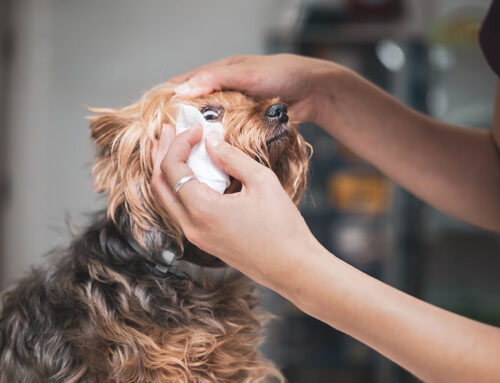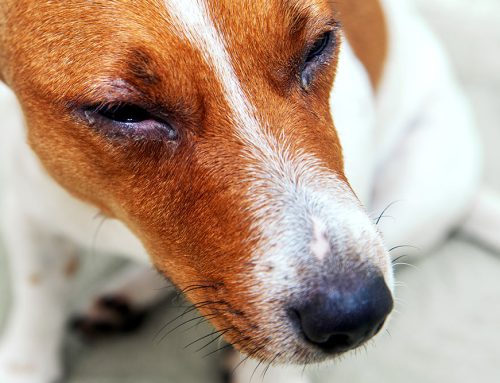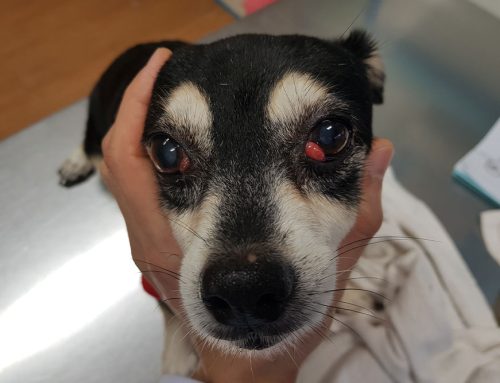One of the most serious “red eye” causes in dogs is primary glaucoma, which can quickly become vision-threatening in affected pets. Pets who develop glaucoma are born with a genetic predisposition and the disease develops later in life—progressing from one eye to include both. The Envision More Veterinary Ophthalmology team believes early intervention is vital to protect vision as long as possible, so we’re explaining to pet owners how to identify risk factors, recognize signs, and seek treatment in the early stages.
Pet primary glaucoma 101
The eye continuously produces fluid (i.e., aqueous humor) that fills the front eye chamber to keep the eye round and nourish the eye structures. Like blood through veins, this fluid constantly flows through the eye, draining from a tiny area at the bottom of the iris (i.e., iridocorneal angle). Glaucoma occurs when something obstructs the drainage outflow, allowing fluid and pressure buildup inside the eye, and leading to optic nerve damage and, ultimately, blindness.
Pets can acquire two glaucoma types—primary or secondary. The secondary form follows another eye issue, such as inflammation, a tumor, or infection. Primary glaucoma is a disease in itself that occurs in pets with no eye disease history, and often is sudden onset. Pets who develop primary glaucoma later in life usually were born with abnormally formed drains. Primary glaucoma usually starts in one eye, and affects the other after a few months or years.
Pet primary glaucoma risk factors
Primary glaucoma is most commonly found in purebred dogs—and cats, but rarely. The disease is seen in young adults, but most commonly develops in middle or older age. Any dog or cat can develop the disease, but multiple breeds are predisposed. Dog breeds at the top of this list include:
- Cocker spaniel
- Siberian husky
- Basset hound
- Beagle
- Chow-Chow
- Shar-pei
- Boston terrier
- Miniature poodle
The few cat breeds that may develop primary glaucoma include:
- Siamese
- Burmese
- Persian
Pet primary glaucoma diagnosis
Primary glaucoma starts when one eye’s pressure becomes elevated, which is easy to miss at home, as pets at this stage often look and act normally. As pressure climbs, the following signs may result:
- Redness
- Cloudy or blue-colored cornea
- Squinting
- Enlarged/bulging eye
- Eye pain—lethargy, poor appetite, head tilt
The main glaucoma diagnosis test is tonometry (i.e., an eye pressure test), which is similar to the “air puff” your own eye doctor may use. Your veterinarian will use a slightly different—and less startling—instrument and also will evaluate your pet’s eye reflexes and test their vision. Unfortunately, many pets are already blind in the first eye when their owners first notice a problem, because these pets do not act differently at home.
If your veterinarian diagnoses glaucoma, they may prescribe eye drops and refer you to a veterinary ophthalmologist for emergency or urgent treatment.
Pet primary glaucoma treatment options
A veterinary ophthalmologist is the best person to treat your pet’s glaucoma. If the pet’s eye pressure is extremely high, emergency treatments depend on the eye’s chances of regaining vision. Vision-saving procedures include:
- Aqueous centesis — Using a needle to remove fluid directly from the eye
- Osmotic diuretics — Drawing fluid from the eyes with IV mannitol
- Repeated eye drops — Repeating doses of strong anti-glaucoma medications to help rapidly lower pressure
Long-term treatment includes eye drops multiple times per day, every day, to lower pressure and control inflammation. Medications control only eye pressure and cannot cure glaucoma completely. Over months or years, medications become less effective and pressure will elevate again. Laser surgery to reduce eye fluid production or a shunt placed inside the drain are options when medications stop working.
Treatment for a permanently blind eye is focused on relieving pain and preventing future pressure spikes and includes:
- Enucleation — Eye removal surgery
- Ciliary body ablation — Injection into the eye to kill fluid-producing cells
Long-term outlook for pet primary glaucoma

Unfortunately, primary glaucoma in pets is always a losing battle. Medications may be effective for several years, or the disease may progress more quickly. Eventually, most pets will become blind. Surgical vision-saving options, which are expensive and cannot be guaranteed, are usually reserved for pets who no longer respond to medications.
Glaucoma treatment is not focused on achieving a cure, but preserving vision for as long as possible and, most importantly, keeping the pet comfortable. High eye pressure is extremely painful, which is why procedures such as eye removal are common. Pet owners often find accepting their pet’s eye removal difficult, but reminding them that the eye is blind, the pet has no emotional attachment to their eye, and that surgery will make them feel better, can help.
Pets who slowly lose their vision often adapt well and learn to use their other senses. Those who lose vision suddenly may become anxious at first, but also eventually adapt. With time, special training techniques, and a few household modifications, a blind pet can enjoy a normal quality of life.
Although glaucoma is usually a losing battle, treatment and close monitoring can help pets retain vision as long as possible and keep them comfortable and pain-free. Rest assured that pets who lose their vision adapt remarkably well and learn to navigate the world in new ways, and can continue to lead healthy and happy lives.
Contact the Envision More Veterinary Ophthalmology team to schedule a consultation and glaucoma screening if you have a high-risk pet, or if you have any concerns about your pet’s current eye health.







Leave A Comment